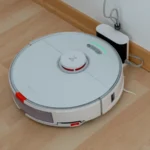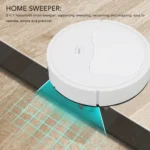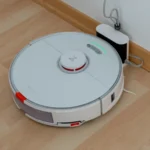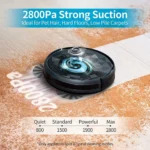After investing in a smart vacuum cleaner, the last thing you want is a failing battery. It can be frustrating to have your cleaning interrupted mid-way. While most smart vacuums have good battery life, they still require maintenance to keep them working efficiently. If you want to extend the life of your smart vacuum cleaner’s battery, there are a few things you can do. From understanding your battery to adopting charging best practices, we’ve compiled ten tips to help you get the most out of your device. So, let’s get started!
Understand Your Smart Vacuum Cleaner’s Battery
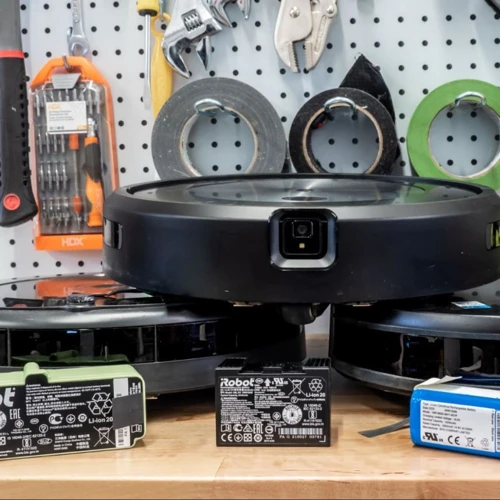
As a smart vacuum cleaner owner, you have likely already experienced the convenience of having your daily cleaning routine taken care of by a robotic device. However, it’s important to understand the battery life of your device to ensure that it is running at its maximum potential. By checking the battery capacity and voltage, knowing when to charge, and avoiding overcharging, you can extend the life of your smart vacuum cleaner’s battery. Let’s dive deeper into these tips and more in order to keep your device running smoothly. And if you’re interested in the latest vacuum charger advancements, check out our recent article on the topic.
Check the Battery Capacity and Voltage
When it comes to extending the battery life of your smart vacuum cleaner, it’s important to start with understanding your battery. Checking the battery capacity and voltage can give you an idea of the current state of your vacuum’s battery, and whether or not it needs to be replaced.
Here is a table to help you understand the different battery capacities and voltages:
| Battery Capacity | Battery Voltage |
|---|---|
| Low Capacity: less than 1800mAh | Low Voltage: less than 12V |
| Medium Capacity: between 1800mAh and 3000mAh | Medium Voltage: between 12V and 14.4V |
| High Capacity: above 3000mAh | High Voltage: above 14.4V |
Checking the battery capacity and voltage regularly can help you identify any issues with your battery before they become bigger problems. If you notice that your vacuum’s battery capacity or voltage is consistently low, it may be time to replace the battery.
In addition to checking the battery capacity and voltage, it’s important to store your smart vacuum cleaner’s battery properly. For tips on safe smart vac battery storage, check out our article on safe smart vac battery storage.
Also, be aware that fast charging can put unnecessary strain on your vacuum’s battery, potentially reducing its overall lifespan. For more information on fast charging and its impact on battery life, check out our article on fast charging your smart vacuum cleaner.
Taking some time to understand your smart vacuum cleaner’s battery can help you extend its lifespan and avoid costly replacements.
Know When to Charge
It is essential to know when to charge your smart vacuum cleaner’s battery to ensure the optimal battery life. Here are some of the things to consider to understand when to charge your device:
- Check the battery life indicator: Most Smart Vacuum cleaners have battery life indicators that inform you when it’s time to recharge the battery. Keep an eye on the battery life indicator, and charge the device when the battery life is low.
- Check the device’s performance:If you notice that the vacuum cleaner’s performance is not up to the mark or if it is running slower than usual, it might be time to charge the device. This usually happens because the device’s battery is running low.
- Plan your cleaning schedule:If you are planning to use the vacuum cleaner for an extended period, ensure that your device’s battery is fully charged before starting the cleaning process.
- Charge after every use: It is always best to charge the device after every use, regardless of the battery level. This ensures the battery is fully charged for the next use.
- Charge before long storage: If you are not planning to use your smart vacuum cleaner for an extended period, charge the battery fully before storing it. This prevents the battery from draining and prolongs the battery life when it is not in use.
Following these steps will extend your smart vacuum cleaner’s battery life significantly. Knowing when to charge your device and how to do it properly is crucial as it can increase the battery’s performance span. If you want to read more on how smart home integration can affect vacuum cleaner battery life, have a look at this article on our website: Smart Home Integration and Your Vacuum Cleaner’s Battery Life.
Avoid Overcharging
One of the most common mistakes when it comes to charging your smart vacuum cleaner’s battery is overcharging. Overcharging can seriously impact the lifespan of your battery and reduce its overall efficiency. To avoid overcharging, it is important to follow these simple tips:
- Monitor charging times: Always keep an eye on the charging time and make sure to stop charging once it reaches the optimal level. Most smart vacuum cleaners come with indicators that will help you determine when the battery is fully charged.
- Avoid leaving your vacuum on charge for extended periods: Leaving your vacuum cleaner on charge constantly can lead to overcharging and ultimately impact the lifespan of your battery. Once your battery is fully charged, unplug the charger and store it in a safe place.
- Be aware of the optimal charging temperature: Charging your smart vacuum cleaner’s battery at extremely low or high temperatures can have a detrimental effect on the battery’s lifespan. Most manufacturers recommend charging the battery at room temperature for the best results.
- Consider investing in a smart charger: A smart charger can help you avoid overcharging your battery by automatically stopping the charging process once the battery is full. This can be a great investment to maximize the longevity of your battery.
By following these simple tips, you can avoid overcharging your smart vacuum cleaner’s battery and ensure it lasts longer. Remember to always be mindful of your battery’s charging time and temperature, and consider investing in a smart charger to help prolong the life of your battery.
Charging Best Practices
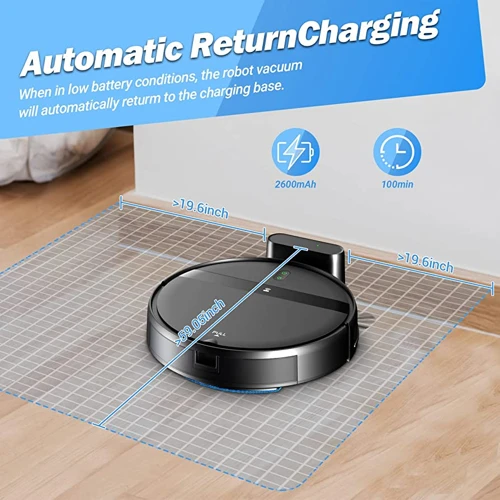
Now that you understand your smart vacuum cleaner’s battery, it’s time to talk about charging best practices to extend its life. Charging your smart vacuum cleaner at the right time and in the right conditions can significantly impact the longevity of your battery. In this section, we’ll go through some effective charging practices that will help keep your smart vacuum cleaner up and running for longer periods. Let’s dive into the details!
Keep Your Smart Vacuum Cleaner’s Battery Topped Up
One simple way to extend the life of your smart vacuum cleaner’s battery is to keep it topped up. This means making sure the battery never fully discharges, but also avoiding overcharging. Here are some tips to help you keep your smart vacuum cleaner’s battery topped up:
| Tip | Description |
|---|---|
| Charge Frequently | Don’t wait until the battery level is critically low before charging. Try to charge your smart vacuum cleaner’s battery after every use, or at least once every few uses, to keep it topped up. |
| Use a Smart Plug | A smart plug can help you schedule charging times for your smart vacuum cleaner, ensuring that it is always charged and ready to go when you need it. |
| Avoid Heat and Cold | Extreme temperatures can damage your smart vacuum cleaner’s battery. Avoid leaving it in direct sunlight, or in a cold garage or basement. |
| Disconnect After Charging | Once your smart vacuum cleaner’s battery is fully charged, unplug it from the charger. Keeping it plugged in can cause overcharging, which can shorten the battery’s lifespan. |
By keeping your smart vacuum cleaner’s battery topped up, you can ensure that it is always ready to go when you need it. Charging frequently, using a smart plug, and avoiding extreme temperatures are all great ways to extend the life of your battery. Additionally, be sure to disconnect your smart vacuum cleaner from the charger once it’s fully charged to avoid overcharging. With these tips, you can get the most out of your smart vacuum cleaner’s battery.
Avoid Deep Discharging
One crucial tip to extend your smart vacuum cleaner’s battery life is to avoid deep discharging. Deep discharging is when you let the battery completely drain out before recharging it.
This can greatly reduce the lifespan of the battery and affect its overall performance. To avoid this, try to recharge the battery before it reaches critically low levels.
Here are some ways to prevent deep discharging:
| Tip | Description |
|---|---|
| Set charging reminders | Make sure you remember to charge your smart vacuum cleaner’s battery before it gets too low. Set reminders on your phone or create a schedule. |
| Use smart charging | If your smart vacuum cleaner has a smart charging feature, make sure to enable it. This feature ensures that the battery is charged to the optimal level without overcharging or undercharging. |
| Don’t wait until it dies | Try to recharge your vacuum’s battery when it reaches around 20-30% instead of waiting until it dies. This will help prevent deep discharging and keep the battery in good condition. |
By following these tips, you can avoid deep discharging and prolong your smart vacuum cleaner’s battery life. Remember, taking care of your battery is an essential part of maintaining its overall performance.
Charge at Optimal Temperatures
To ensure that your smart vacuum cleaner’s battery lasts as long as possible, it’s important to charge it at optimal temperatures. The ideal temperature range for charging Li-ion batteries like those found in smart vacuum cleaners is between 10°C and 30°C.
Charging your smart vacuum cleaner’s battery at temperatures outside of this range, whether too hot or too cold, can cause damage and shorten its lifespan drastically.
Here’s a table to help you understand the impact of temperature on battery life:
| Charging Temperature | Battery Lifespan |
|---|---|
| 0°C-5°C | 50% of the battery’s rated lifespan |
| 5°C-10°C | 75% of the battery’s rated lifespan |
| 10°C-20°C | 100% of the battery’s rated lifespan |
| 20°C-45°C | 90% of the battery’s rated lifespan |
| Above 45°C | 50% of the battery’s rated lifespan |
As you can see from the table, charging your smart vacuum cleaner’s battery outside of the optimal temperature range can result in a significant reduction in overall battery lifespan. So, it’s important to make sure that you’re charging your device in an environment that falls within that range.
If you’re charging your device outside of the optimal temperature range, you may notice that your smart vacuum cleaner’s battery doesn’t last as long as it should. It may also experience other issues, such as reduced charging speed or overheating.
To extend your smart vacuum cleaner’s battery life, make sure to keep it charged at optimal temperatures. Keep it in a cool, dry place when not in use, and never leave it in direct sunlight. By following these guidelines, you can ensure that your device stays in good condition and lasts as long as possible.
Other Battery-saving Tips
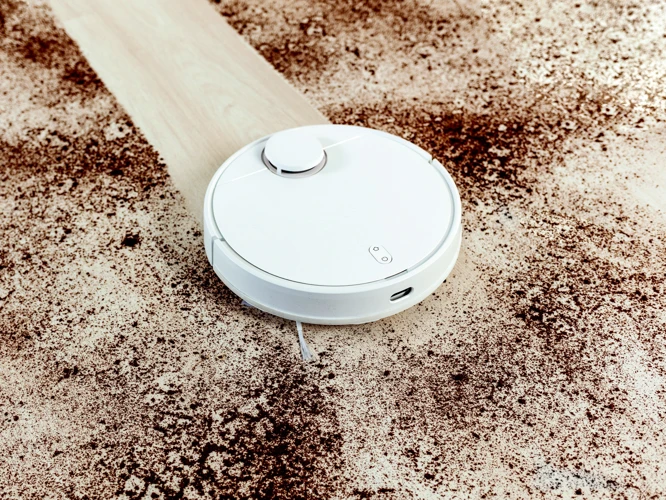
Now that you understand the basics of your smart vacuum cleaner’s battery and have learned best practices for charging it, let’s explore some additional tips for extending its battery life. By following these simple yet effective steps, you’ll be able to get the most out of your device, without worrying about its battery draining too quickly. So, let’s dive into some handy tricks and tips that will help keep your smart vacuum cleaner’s battery running smoothly.
Keep Your Smart Vacuum Cleaner Clean
One of the best ways to extend the battery life of your smart vacuum cleaner is to keep it clean. A dirty vacuum cleaner not only affects its performance but can also shorten the life of its battery. Here are some things you should do to keep your smart vacuum cleaner clean:
- Clean the Brushes Regularly: The brushes of your vacuum cleaner tend to accumulate dust and debris over time. Clean them regularly using a soft brush or a comb to ensure that they work efficiently. This will not only reduce the load on your vacuum cleaner’s motor but also extend the life of its battery.
- Empty the Dustbin: A full dustbin can reduce the suction power of your vacuum cleaner and make it consume more power. Make it a habit to empty the dustbin after every use.
- Filter Maintenance: Most smart vacuum cleaners come with washable filters. Clean them regularly, as dirty filters can reduce the suction power of your vacuum cleaner and make it consume more energy.
- Check for Blockages: A blockage in the brush, hose or any other part of your vacuum cleaner can put additional strain on the motor and cause it to consume more power. Check for blockages regularly and remove them if any are found.
- Clean the Wheels: The wheels of your vacuum cleaner can accumulate dirt and debris over time. Clean them regularly to ensure that your vacuum cleaner moves smoothly and consumes minimum power.
By keeping your smart vacuum cleaner clean, you can ensure that it works efficiently and consumes less power, thereby extending the life of its battery.
Block off Unnecessary Areas
Your smart vacuum cleaner might be intelligent enough to navigate around your home, but that doesn’t mean it needs to clean every inch of it. Here are some tips for blocking off unnecessary areas and extending the battery life of your device:
- Identify areas that are already clean: Before using your smart vacuum cleaner, make sure to go around your home and clear away any debris or clutter that might be blocking its path. By doing so, you’ll help your device avoid unnecessary areas that have already been cleaned.
- Use physical barriers: If there are certain areas that you don’t want your smart vacuum cleaner to approach, you can use physical barriers to block them off. This might include baby gates or other temporary walls that can be easily moved or dismantled when needed.
- Set up virtual boundaries: Many smart vacuum cleaners come with features that allow you to set up virtual boundaries that your device won’t cross. Some models even come with magnetic strips that you can place around areas you want to avoid.
- Disable certain sensors: In some cases, you may be able to disable certain sensors on your smart vacuum cleaner to prevent it from entering unwanted areas. Be sure to consult your device’s user manual before doing so, as disabling certain sensors could impact the overall functionality of your device.
By taking these simple steps, you can help your smart vacuum cleaner focus on the areas that need the most attention and avoid unnecessary areas that might drain its battery. Plus, you’ll save time and energy by not having to move furniture or other obstacles out of the way every time you clean.
Use Low Power Modes
To extend your smart vacuum cleaner’s battery life, it’s important to make use of low power modes. These modes reduce the power usage of the device and help prolong the battery life. Let’s take a closer look at some of the best low power modes to use:
| Low Power Modes | Description |
|---|---|
| Eco Mode | This mode allows the vacuum to clean for longer periods by reducing the suction power. This is ideal for cleaning less-dirty areas or smaller spaces. |
| Quiet Mode | This setting helps reduce the noise level produced by the vacuum while cleaning. |
| Spot Cleaning | This mode allows the vacuum to concentrate on a specific area, resulting in more efficient cleaning and reduced power consumption. |
Using low power modes will not only help save battery life, but also reduce the wear and tear on the device, ensuring it lasts longer. So take advantage of the various options available on your smart vacuum cleaner and adjust them based on your cleaning needs. This will not only benefit your vacuum cleaner, but your wallet as well in the long run.
Turn off Advanced Features
Some smart vacuum cleaner models come with advanced features that can drain their batteries quickly. While these features are meant to enhance the user experience, they may not be necessary all the time. To extend the battery life of your smart vacuum cleaner, consider turning off advanced features when they are not needed. Here are some examples:
- Scheduling – Some smart vacuum cleaners have a scheduling feature that allows you to set a specific time for cleaning. While this is convenient, it can drain the battery if it runs unnecessarily. If you are not using the scheduling feature, turn it off to save battery.
- Mapping – Mapping is a useful feature that allows your smart vacuum cleaner to create a floor plan of your home. However, this feature requires a lot of processing power, which can drain the battery quickly. If you do not need to update the map or create a new one, turn off the mapping feature.
- Cyclone Mode – Cyclone mode is a high-power cleaning mode that is designed to pick up stubborn dirt and pet hair. While it is effective, it can significantly reduce the battery life of your vacuum cleaner. Only use it when necessary.
- Auto-Adjusting Suction – Some smart vacuum cleaners have a feature that automatically adjusts suction power based on the surface it is cleaning. While this is useful, it can drain the battery if it is constantly adjusting. If you are cleaning a single type of surface, turn off the auto-adjusting suction feature to save battery.
By turning off these advanced features when you do not need them, you can significantly extend the battery life of your smart vacuum cleaner. This means that you can clean more often without having to recharge the battery as frequently. Remember to weigh the benefits of these features against their impact on battery life, and adjust accordingly.
Consider Replacing Your Battery
As much as we try to extend the life of our smart vacuum cleaner’s battery, there may come a time when a replacement is necessary. This can be a frustrating situation, but with the right knowledge and precautions, it can be a relatively easy fix. In this section, we’ll explore when it’s time to replace your battery, how to choose a high-quality replacement, and how to safely and carefully replace the battery on your own. So, let’s delve into the world of smart vacuum cleaner batteries and learn about the replacement process.
Know When to Replace the Battery
As much as we try to extend the battery life of our smart vacuum cleaners, there will come a point where the battery will need to be replaced. It’s important to know when this time comes to ensure that your vacuum continues to function efficiently. Here are some signs to look out for:
| Signs That Your Smart Vacuum Cleaner Battery Needs Replacement |
|---|
| Shorter battery life: If you notice that your smart vacuum cleaner is holding a charge for a significantly shorter time than it used to, it’s a sign that the battery is beginning to degrade and may need to be replaced soon. |
| Decreased cleaning performance: As the battery starts to fail, you may begin to see a decrease in the cleaning performance of your smart vacuum cleaner. It may not be able to clean as thoroughly or for as long, even when fully charged. |
| Inability to hold a charge: If your smart vacuum cleaner is having trouble holding a charge or won’t turn on even after charging, this could signify that the battery has reached the end of its life. |
| Visible damage: If you notice any visible damage to the battery or if it’s leaking, it’s time to replace it immediately for safety reasons. |
Remember that a failing battery can affect the overall performance of your smart vacuum cleaner. Knowing when to replace the battery can save you from frustration and ensure you get the most out of your device. When you do decide to replace the battery, make sure to choose a high-quality replacement and replace it carefully and safely to avoid any damage to your device or injury to yourself.
Choose a High Quality Replacement Battery
When it comes to replacing your smart vacuum cleaner’s battery, choosing a high quality replacement is crucial for ensuring optimal performance and lifespan. Here are some tips for choosing a replacement battery:
- Research the brand: Look for reputable brands that specialize in manufacturing batteries specifically for smart vacuum cleaners. Check reviews and ratings to get an idea of their quality and reliability.
- Check the specifications: Make sure the replacement battery matches the specifications of the original battery in terms of voltage, capacity and size. Using an incompatible battery can damage your device or even cause safety hazards.
- Consider the type of battery: Look for batteries that feature high-quality cells such as lithium-ion or nickel-metal hydride, which are known for their durability and efficiency.
- Compare prices: While it’s important to invest in a high-quality replacement battery, it doesn’t mean you have to break the bank. Compare prices of different battery brands and sellers to ensure you’re getting the best deal.
- Pay attention to warranty: Choose batteries that come with a warranty or guarantee. This will protect you from any defects or premature failures, and will give you peace of mind.
By following these tips, you can find a high-quality replacement battery for your smart vacuum cleaner that will keep it running smoothly and efficiently for years to come. Remember, investing in a good replacement battery is an investment in the longevity and performance of your device.
Replace the Battery Carefully and Safely
Replacing the battery of your smart vacuum cleaner can help you extend its battery life, but it is important to do so carefully and safely to avoid damaging the device. Here are some tips to ensure a safe and successful battery replacement:
| Tip | Description |
|---|---|
| 1. | Choose the Right Replacement Battery |
| Make sure to choose a high-quality replacement battery that is compatible with your smart vacuum cleaner’s model and specifications. Otherwise, you risk damaging your device or reducing its battery life. | |
| 2. | Follow the User Manual |
| Refer to the user manual of your smart vacuum cleaner for specific instructions on how to replace the battery. Follow the steps carefully to avoid making mistakes that can damage your device or cause harm to yourself. | |
| 3. | Power off the Device Before Replacement |
| Before beginning the battery replacement, make sure to power off your smart vacuum cleaner to avoid accidental shocks or damage to sensitive parts. | |
| 4. | Remove the Old Battery |
| Carefully remove the old battery from your smart vacuum cleaner, following the instructions in the user manual. Be gentle and avoid using excessive force or sharp objects that may damage the device or injure yourself. | |
| 5. | Install the New Battery Correctly |
| Place the new battery in the correct position and ensure that it fits snugly and securely. Check the user manual for specific instructions on how to install the battery properly. | |
| 6. | Test the New Battery |
| After installing the new battery, power on your smart vacuum cleaner and test it to ensure that the battery is working properly. Run a cleaning cycle or use the device for an extended period of time to see how well the battery performs. |
By following these tips, you can safely and effectively replace the battery of your smart vacuum cleaner and ensure that your device continues to work efficiently for a long time. Remember to always prioritize safety and caution when dealing with electronic devices and their components.
Conclusion
In conclusion, taking care of your smart vacuum cleaner’s battery is crucial if you want it to perform at its best and have a long lifespan. By understanding the basic characteristics of the battery and following the best charging practices, you can extend the battery life and avoid unnecessary replacement costs. Remember to avoid overcharging, keep the battery topped up, and charge at optimal temperatures. Besides, maintaining a clean and block-free vacuum cleaner can also reduce the workload and sustain the battery life. If you want to save even more power, consider turning off advanced features and using low power modes. And when the time comes, replacing the battery can be a wise investment, but be sure to choose a high-quality replacement and follow the safety protocols. By following these tips, you can ensure that your smart vacuum cleaner is always ready to tackle your cleaning needs without interruptions.
Frequently Asked Questions
1. Can I use any type of charging cable for my smart vacuum cleaner?
No, it is important to use the charging cable that came with your smart vacuum cleaner to avoid overcharging or damaging the battery.
2. Is it necessary to charge the battery before using my smart vacuum cleaner for the first time?
Yes, it is recommended to fully charge the battery before using your smart vacuum cleaner for the first time for optimal battery life.
3. How often should I charge my smart vacuum cleaner?
It is recommended to charge your smart vacuum cleaner after each use to ensure the battery is topped up and ready for the next use.
4. How can I know if my smart vacuum cleaner’s battery is low?
Your smart vacuum cleaner should have an indicator light that shows when the battery is low.
5. Can I overcharge my smart vacuum cleaner’s battery?
Yes, it is important to avoid overcharging the battery as it can cause damage and reduce the battery’s lifespan.
6. Is it safe to charge my smart vacuum cleaner overnight?
It is not recommended to charge your smart vacuum cleaner overnight as it can lead to overcharging and damage to the battery.
7. Will using low power modes affect the cleaning performance of my smart vacuum cleaner?
Yes, using low power modes may affect the cleaning performance, but it will extend the battery life of your smart vacuum cleaner.
8. How can I clean my smart vacuum cleaner?
You can clean your smart vacuum cleaner by wiping it with a clean, damp cloth and removing any debris from the brushroll and filter.
9. How do I know if it’s time to replace my smart vacuum cleaner’s battery?
If your smart vacuum cleaner’s battery no longer holds a charge or the cleaning performance has significantly decreased, it may be time to replace the battery.
10. Can I replace my smart vacuum cleaner’s battery myself?
Yes, you can replace your smart vacuum cleaner’s battery yourself, but it is recommended to follow the manufacturer’s instructions carefully and ensure proper safety precautions are taken.

